Assessment of the Environmental Impacts of Bridge Designs Involving UHPFRC
Abstract
:1. Introduction
2. Materials and Methods
- Bridge construction—low uncertainties;
- Bridge construction and maintenance—medium uncertainties;
- Bridge construction, maintenance, and elimination—high uncertainties.
3. Results
3.1. Case Study Presentation—Rigi Bridge
3.2. Structural Designs
3.2.1. Concrete Bridge
3.2.2. Composite Timber–UHPFRC Bridge
3.2.3. UHPFRC Bridge
3.2.4. Design Summary
3.3. System Boundary and Functional Unit
3.4. Life Cycle Inventory Assessment
3.4.1. Construction Process
3.4.2. Maintenance and Deconstruction
3.5. Sensitivity Analysis
3.5.1. Bridge Service Duration
3.5.2. Environmentally Friendly UHPFRC Mix
3.5.3. CO2 Stored in the Timber
4. Discussion
5. Conclusions
- Environmental impacts of bridges should include three time horizon assessments: first considering only the construction phase, then including the scheduled maintenance, and finally adding the elimination.
- Maintenance represents a large part of the impacts of conventional structures. The use of UHPFRC for bridge decks significantly reduces the impacts of maintenance.
- The composite timber–UHPFRC bridge has slightly lower impacts than the full-UHPFRC bridge. Both appreciably reduce environmental impacts when compared to conventional reinforced concrete structures, showing that using UHPFRC in road-bridge design can lead to less environmentally detrimental bridge construction.
Author Contributions
Funding
Institutional Review Board Statement
Informed Consent Statement
Data Availability Statement
Conflicts of Interest
References
- Bajželj, B.; Allwood, J.M.; Cullen, J.M. Designing Climate Change Mitigation Plans That Add Up. Environ. Sci. Technol. 2013, 47, 8062–8069. [Google Scholar] [CrossRef] [PubMed]
- Favier, A.; Scrivener, K.; Habert, G. Decarbonizing the Cement and Concrete Sector: Integration of the Full Value Chain to Reach Net Zero Emissions in Europe. IOP Conf. Ser. Earth Environ. Sci. 2019, 225, 012009. [Google Scholar] [CrossRef]
- Habert, G.; Miller, S.A.; John, V.M.; Provis, J.L.; Favier, A.; Horvath, A.; Scrivener, K.L. Environmental Impacts and Decarbonization Strategies in the Cement and Concrete Industries. Nat. Rev. Earth Environ. 2020, 1, 559–573. [Google Scholar] [CrossRef]
- Damineli, B.L.; Kemeid, F.M.; Aguiar, P.S.; John, V.M. Measuring the Eco-Efficiency of Cement Use. Cem. Concr. Compos. 2010, 32, 555–562. [Google Scholar] [CrossRef]
- Proske, T.; Hainer, S.; Rezvani, M.; Graubner, C.-A. Eco-Friendly Concretes with Reduced Water and Cement Contents—Mix Design Principles and Laboratory Tests. Cem. Concr. Res. 2013, 51, 38–46. [Google Scholar] [CrossRef]
- Teh, S.H.; Wiedmann, T.; Castel, A.; de Burgh, J. Hybrid Life Cycle Assessment of Greenhouse Gas Emissions from Cement, Concrete and Geopolymer Concrete in Australia. J. Clean. Prod. 2017, 152, 312–320. [Google Scholar] [CrossRef] [Green Version]
- Scrivener, K.; Martirena, F.; Bishnoi, S.; Maity, S. Calcined Clay Limestone Cements (LC3). Cem. Concr. Res. 2018, 114, 49–56. [Google Scholar] [CrossRef]
- Ghyoot, M.; Devlieger, L.; Billiet, L.; Warnier, A. Rotor Déconstruction et réemploi: Comment faire circuler les éléments de construction; Presses Polytechniques et Universitaires Romandes: Lausanne, Switzerland, 2018; ISBN 978-2-88915-239-1. [Google Scholar]
- Huuhka, S.; Kaasalainen, T.; Hakanen, J.H.; Lahdensivu, J. Reusing Concrete Panels from Buildings for Building: Potential in Finnish 1970s Mass Housing. Resour. Conserv. Recycl. 2015, 101, 105–121. [Google Scholar] [CrossRef]
- Addis, B. Building with Reclaimed Components and Materials: A Design Handbook for Reuse and Recycling; Earthscan: London, UK, 2006; ISBN 978-1-84407-274-3. [Google Scholar]
- Barriers for Deconstruction and Reuse/Recycling of Construction Materials. Rapport CIB 397; Nakajima, S., Russell, M., Eds.; CIB: Rotterdam, The Netherlands, 2014. [Google Scholar]
- Pamenter, S.; Myers, R.J. Decarbonizing the Cementitious Materials Cycle: A Whole-Systems Review of Measures to Decarbonize the Cement Supply Chain in the UK and European Contexts. J. Ind. Ecol. 2021, 25, 359–376. [Google Scholar] [CrossRef]
- Graybeal, B.; Brühwiler, E.; Kim, B.-S.; Toutlemonde, F.; Voo, Y.L.; Zaghi, A. International Perspective on UHPC in Bridge Engineering. J. Bridge Eng. 2020, 25, 04020094. [Google Scholar] [CrossRef]
- Brühwiler, E.; Denarié, E. Rehabilitation and Strengthening of Concrete Structures Using Ultra-High Performance Fibre Reinforced Concrete. Struct. Eng. Int. 2013, 23, 450–457. [Google Scholar] [CrossRef]
- Brühwiler, E. UHPFRC Technology to Enhance the Performance of Existing Concrete Bridges. Struct. Infrastruct. Eng. 2020, 16, 94–105. [Google Scholar] [CrossRef]
- Oesterlee, C. Structural Response of Reinforced UHPFRC and RC Composite Members. Ph.D. Thesis, EPFL, Lausanne, Switzerland, 2010. [Google Scholar]
- Brühwiler, E. Structural UHPFRC to Enhance Bridges. In Proceedings of the 2nd International Conference on UHPC Materials and Structures UHPC 2018, Fuzhou, China, 7–10 November 2018; Volume 129, pp. 140–158. [Google Scholar]
- Paul, S.C.; van Zijl, G.P.; Šavija, B. Effect of Fibers on Durability of Concrete: A Practical Review. Materials 2020, 13, 4562. [Google Scholar] [CrossRef] [PubMed]
- Denarié, E.; Brühwiler, E. Cast-on Site UHPFRC for Improvement of Existing Structures—Achievements over the Last 10 Years in Practice and Research. In Proceedings of the HPFRCC7: 7th workshop on High Performance Fiber Reinforced Cement Composites, Stuttgart, Germany, 1–3 June 2015. [Google Scholar]
- Toutlemonde, F.; Roenelle, P.; Hajar, Z.; Simon, A.; Lapeyrere, R.; Martin, R.; Ramanich, S.; BARON, L. Long-Term Material Performance Checked on World’s Oldest UHPFRC Road Bridges at Bourg-Lès-Valence. In Proceedings of the RILEM-fib-AFGC Int. Symposium on Ultra-High Performance Fibre-Reinforced Concrete, UHPFRC 2013, Marseille, France, 1–3 October 2013. [Google Scholar]
- Coenen, T.B.; Santos, J.; Fennis, S.A.; Halman, J.I. Development of a Bridge Circularity Assessment Framework to Promote Resource Efficiency in Infrastructure Projects. J. Ind. Ecol. 2021, 25, 288–304. [Google Scholar] [CrossRef]
- CEN EN 15978: 2011 Sustainability of Construction Works. Assessment of Environmental Performance of Buildings. Calculation Method. 2011. Available online: https://www.en-standard.eu/bs-en-15978-2011-sustainability-of-construction-works-assessment-of-environmental-performance-of-buildings-calculation-method/ (accessed on 29 October 2021).
- International Organisation for Standardisation ISO 14040 Environmental Management—Life Cycle Assessment—Principles and Framework. Available online: https://www.iso.org/cms/render/live/en/sites/isoorg/contents/data/standard/03/74/37456.html (accessed on 7 May 2021).
- Du, G.; Safi, M.; Pettersson, L.; Karoumi, R. Life Cycle Assessment as a Decision Support Tool for Bridge Procurement: Environmental Impact Comparison among Five Bridge Designs. Int. J. Life Cycle Assess. 2014, 19, 1948–1964. [Google Scholar] [CrossRef]
- Du, G.; Karoumi, R. Environmental Life Cycle Assessment Comparison between Two Bridge Types: Reinforced Concrete Bridge and Steel Composite Bridge. In Proceedings of the International Conference on Sustainable Construction Materials & Technologies, Kyoto, Japan, 18–21 August 2013. [Google Scholar]
- Du, G.; Karoumi, R. Life Cycle Assessment Framework for Railway Bridges: Literature Survey and Critical Issues. Struct. Infrastruct. Eng. 2014, 10, 277–294. [Google Scholar] [CrossRef]
- Hettinger, A.; Birat, J.; Hechler, O.; Braun, M. Sustainable bridges–LCA for a composite and a concrete bridge. In Economical Bridge Solutions Based on Innovative Composite Dowels and Integrated Abutments; Springer: Berlin/Heidelberg, Germany, 2015; pp. 45–56. [Google Scholar]
- Kendall, A.; Keoleian, G.A.; Helfand, G.E. Integrated Life-Cycle Assessment and Life-Cycle Cost Analysis Model for Concrete Bridge Deck Applications. J. Infrastruct. Syst. 2008, 14, 214–222. [Google Scholar] [CrossRef]
- Pang, B.; Yang, P.; Wang, Y.; Kendall, A.; Xie, H.; Zhang, Y. Life Cycle Environmental Impact Assessment of a Bridge with Different Strengthening Schemes. Int. J. Life Cycle Assess. 2015, 20, 1300–1311. [Google Scholar] [CrossRef]
- Penadés-Plà, V.; García-Segura, T.; Martí, J.V.; Yepes, V. An Optimization-LCA of a Prestressed Concrete Precast Bridge. Sustainability 2018, 10, 685. [Google Scholar] [CrossRef] [Green Version]
- Zhang, Y.-R.; Wu, W.-J.; Wang, Y.-F. Bridge Life Cycle Assessment with Data Uncertainty. Int. J. Life Cycle Assess. 2016, 21, 569–576. [Google Scholar] [CrossRef]
- Randl, N.; Steiner, T.; Ofner, S.; Baumgartner, E.; Mészöly, T. Development of UHPC Mixtures from an Ecological Point of View. Constr. Build. Mater. 2014, 67, 373–378. [Google Scholar] [CrossRef] [Green Version]
- Stengel, T.; Schießl, P. 22—Life cycle assessment (LCA) of ultra high performance concrete (UHPC) structures. In Eco-Efficient Construction and Building Materials; Pacheco-Torgal, F., Cabeza, L.F., Labrincha, J., de Magalhães, A., Eds.; Woodhead Publishing: Sawston, UK, 2014; pp. 528–564. ISBN 978-0-85709-767-5. [Google Scholar]
- Pushkar, S.; Ribakov, Y. Life-Cycle Assessment of Strengthening Pre-Stressed Normal-Strength Concrete Beams with Different Steel-Fibered Concrete Layers. Sustainability 2020, 12, 7958. [Google Scholar] [CrossRef]
- Keoleian, G.A.; Kendall, A.; Dettling, J.E.; Smith, V.M.; Chandler, R.F.; Lepech, M.D.; Li, V.C. Life Cycle Modeling of Concrete Bridge Design: Comparison of Engineered Cementitious Composite Link Slabs and Conventional Steel Expansion Joints. J. Infrastruct. Syst. 2005, 11, 51–60. [Google Scholar] [CrossRef]
- Habert, G.; Denarié, E.; Šajna, A.; Rossi, P. Lowering the Global Warming Impact of Bridge Rehabilitations by Using Ultra High Performance Fibre Reinforced Concretes. Cem. Concr. Compos. 2013, 38, 1–11. [Google Scholar] [CrossRef] [Green Version]
- Hajiesmaeili, A.; Pittau, F.; Denarié, E.; Habert, G. Life Cycle Analysis of Strengthening Existing RC Structures with R-PE-UHPFRC. Sustainability 2019, 11, 6923. [Google Scholar] [CrossRef] [Green Version]
- Sameer, H.; Weber, V.; Mostert, C.; Bringezu, S.; Fehling, E.; Wetzel, A. Environmental Assessment of Ultra-High-Performance Concrete Using Carbon, Material, and Water Footprint. Materials 2019, 12, 851. [Google Scholar] [CrossRef] [Green Version]
- O’Born, R. Life Cycle Assessment of Large Scale Timber Bridges: A Case Study from the World’s Longest Timber Bridge Design in Norway. Transp. Res. Part D Transp. Environ. 2018, 59, 301–312. [Google Scholar] [CrossRef]
- Rodrigues, J.N.; Providência, P.; Dias, A.M.P.G. Sustainability and Lifecycle Assessment of Timber-Concrete Composite Bridges. J. Infrastruct. Syst. 2017, 23, 04016025. [Google Scholar] [CrossRef]
- Fragiacomo, M.; Gregori, A.; Xue, J.; Demartino, C.; Toso, M. Timber-Concrete Composite Bridges: Three Case Studies. J. Traffic Transp. Eng. Engl. Ed. 2018, 5, 429–438. [Google Scholar] [CrossRef]
- Pousette, A.; Malo, K.A.; Thelandersson, S.; Fortino, S.; Salokangas, L.; Wacker, J. Durable Timber Bridges—Final Report and Guidelines; SP Rapport; RISE Research Institutes of Sweden: Skellefteå, Sweden, 2017; p. 177. [Google Scholar]
- Meyer-Veltrup, L.; Brischke, C.; Niklewski, J.; Frühwald Hansson, E. Design and Performance Prediction of Timber Bridges Based on a Factorization Approach. Wood Mater. Sci. Eng. 2018, 13, 167–173. [Google Scholar] [CrossRef]
- Mahnert, K.-C.; Hundhausen, U. A Review on the Protection of Timber Bridges. Wood Mater. Sci. Eng. 2018, 13, 152–158. [Google Scholar] [CrossRef]
- Wernet, G.; Bauer, C.; Steubing, B.; Reinhard, J.; Moreno-Ruiz, E.; Weidema, B. The Ecoinvent Database Version 3 (Part I): Overview and Methodology. Int. J. Life Cycle Assess. 2016, 21, 1218–1230. [Google Scholar] [CrossRef]
- Krey, V.; Masera, O.; Blanford, G.; Bruckner, T.; Cooke, R.; Fisher-Vanden, K.; Haberl, H.; Hertwich, E.; Kriegler, E.; Mueller, D. Annex 2-Metrics and Methodology. In Climate Change 2014: Mitigation of Climate Change. IPCC Working Group III Contribution to AR5; Cambridge University Press: Cambridge, UK, 2014. [Google Scholar]
- Hischier, R.; Weidema, B.; Althaus, H.-J.; Bauer, C.; Doka, G.; Dones, R.; Frischknecht, R.; Hellweg, S.; Humbert, S.; Jungbluth, N. Implementation of Life Cycle Impact Assessment Methods; Ecoinvent Report. 2010. Available online: https://ecoinvent.org/wp-content/uploads/2020/08/201007_hischier_weidema_implementation_of_lcia_methods.pdf (accessed on 29 October 2021).
- Frischknecht, R.; Knöpfel, S.B. Ecological Scarcity 2013—New Features and Its Application in Industry and Administration—54th LCA Forum, Ittigen/Berne, Switzerland, December 5, 2013. Int. J. Life Cycle Assess. 2014, 19, 1361–1366. [Google Scholar] [CrossRef]
- Goedkoop, M.; Heijungs, R.; Huijbregts, M.; De Schryver, A.; Struijs, J.; Van Zelm, R. ReCiPe 2008: A life cycle impact assessment method which comprises harmonised category indicators at the midpoint and the endpoint level. Impact Assess. 2009, 1, 1–126. [Google Scholar]
- Hajiesmaeili, A.; Denarié, E. Next Generation UHPFRC for Sustainable Structural Applications. In Proceedings of the DSCS 2018: 2nd International Workshop on Durability and Sustainability of Concrete Structures, Moscow, Russia, 6–7 June 2018. [Google Scholar]
- Brühwiler, E.; Vogel, T.; Lang, T.; Lüchinger, P. Swiss Standards for Existing Structures. Struct. Eng. Int. 2012, 22, 275–280. [Google Scholar] [CrossRef]
- Koordinationskonferenz der Bau- und Liegenschaftsorgane der öffentlichen Bauherren KBOB. Ökobilanzdaten im Baubereich 2009/1:2016. Available online: https://www.kbob.admin.ch/kbob/de/home/themen-leistungen/nachhaltiges-bauen/oekobilanzdaten_baubereich.html (accessed on 3 June 2021).
- Walo UHFB Bridge in Tavern. Available online: https://walo.ch/projekte/uhfb-bruecke-in-taverne/ (accessed on 9 March 2021).
- Fivet, C.; Brütting, J. Nothing Is Lost, Nothing Is Created, Everything Is Reused: Structural Design for a Circular Economy. Struct. Eng. 2020, 98, 74–81. [Google Scholar]
- Profft, I.; Mund, M.; Weber, G.-E.; Weller, E.; Schulze, E.-D. Forest Management and Carbon Sequestration in Wood Products. Eur. J. For. Res. 2009, 128, 399–413. [Google Scholar] [CrossRef] [Green Version]
- Werner, F.; Taverna, R.; Hofer, P.; Richter, K. Carbon Pool and Substitution Effects of an Increased Use of Wood in Buildings in Switzerland: First Estimates. Ann. For. Sci. 2005, 62, 889–902. [Google Scholar] [CrossRef] [Green Version]
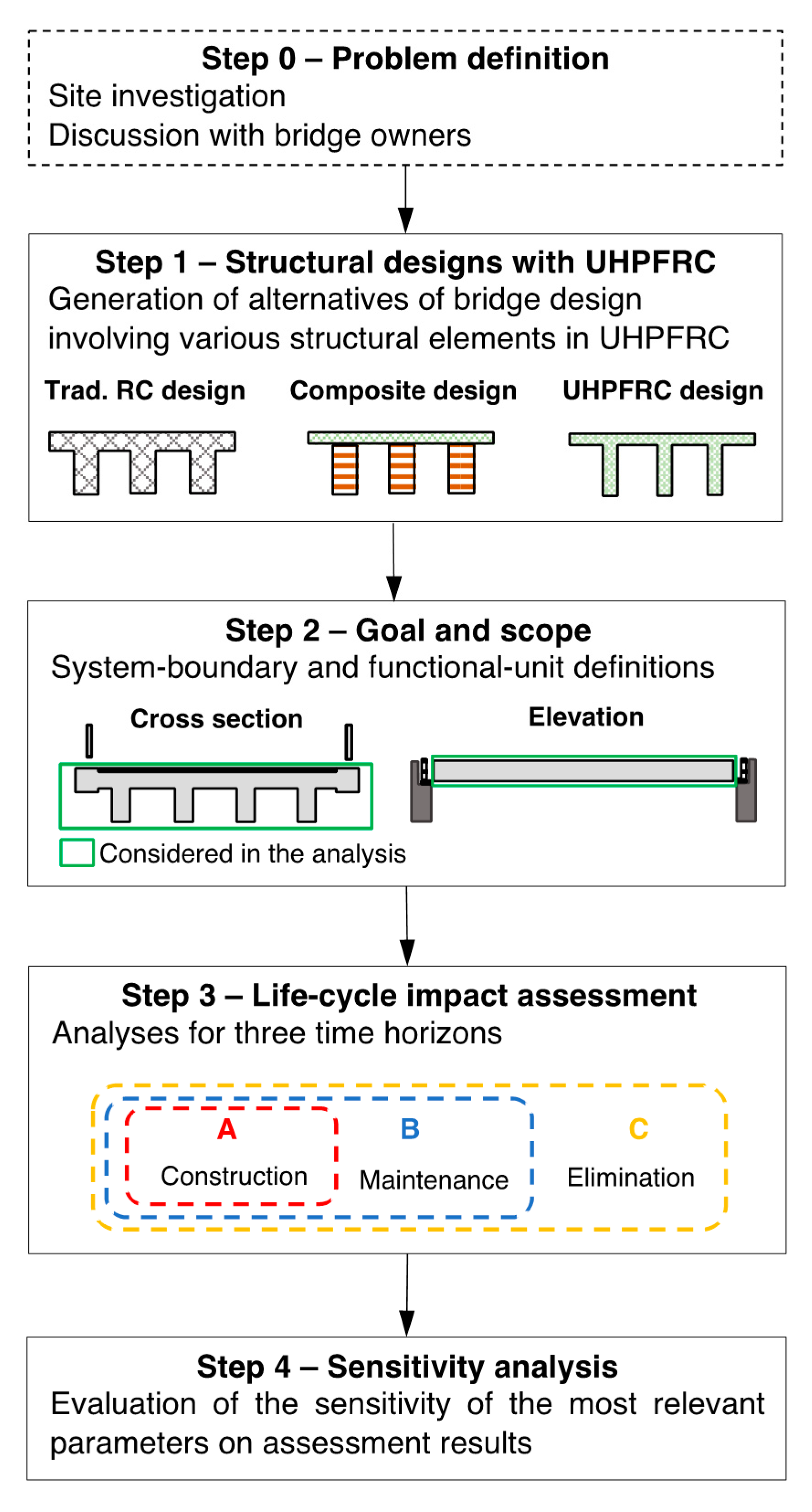
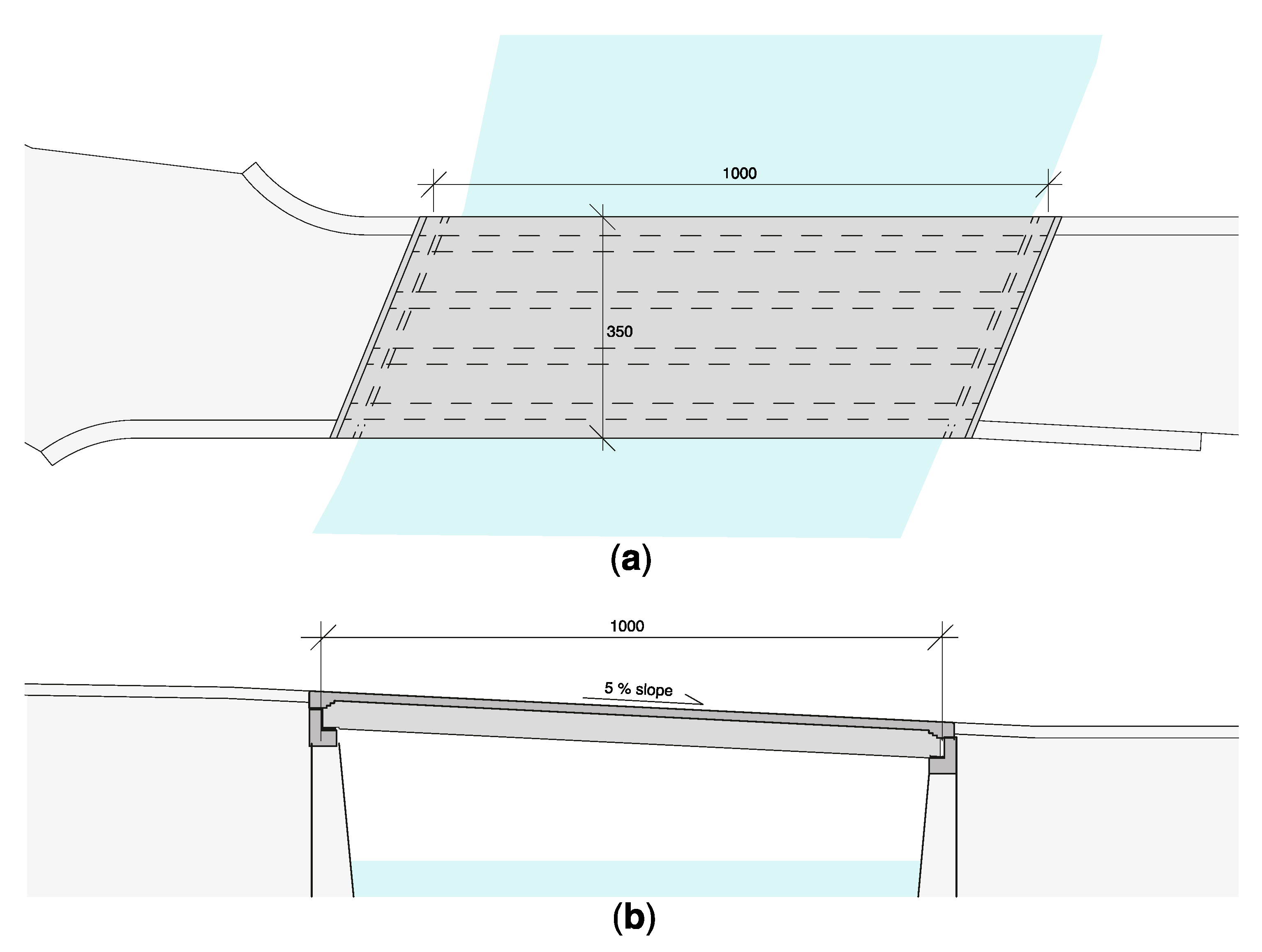
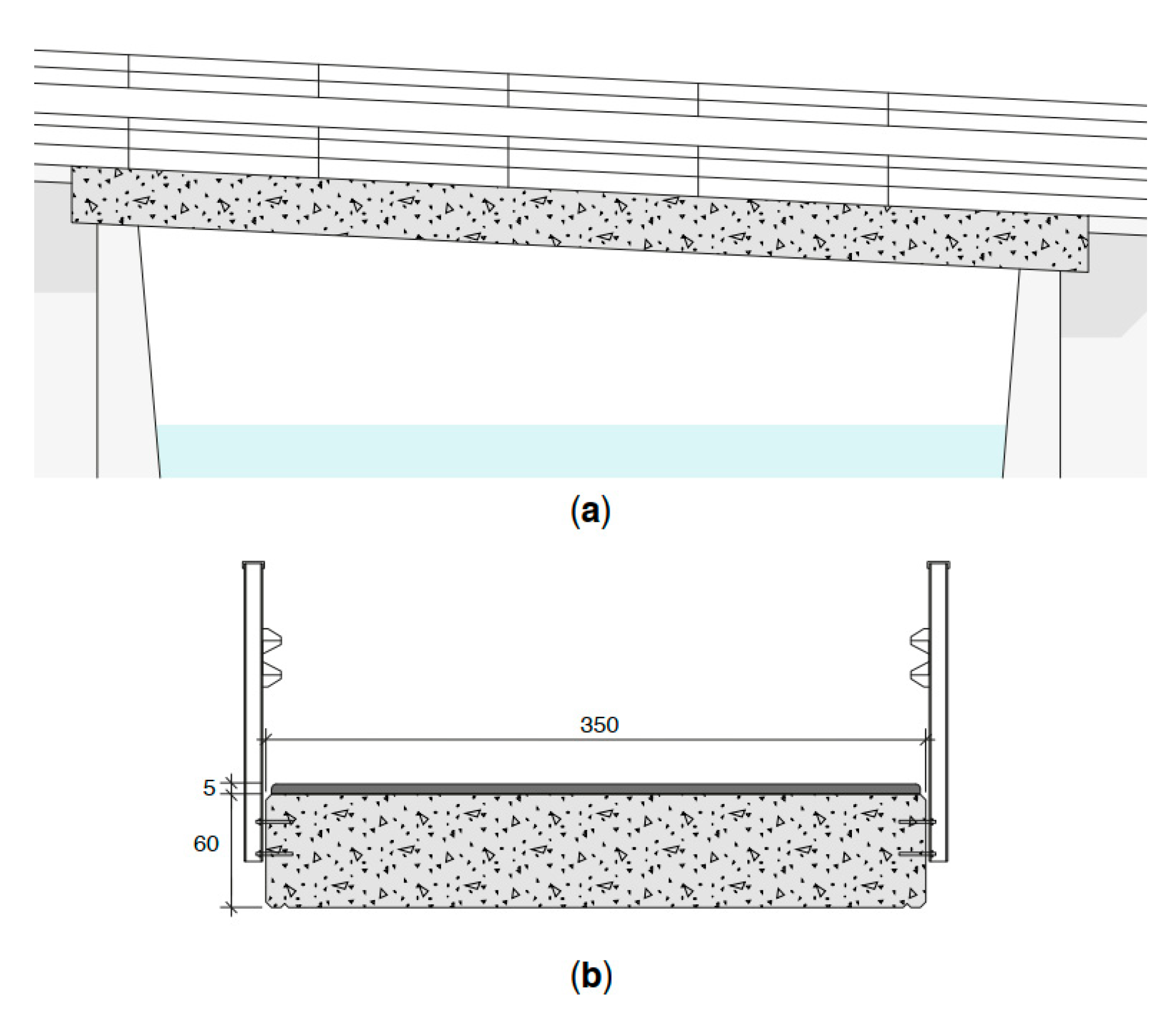
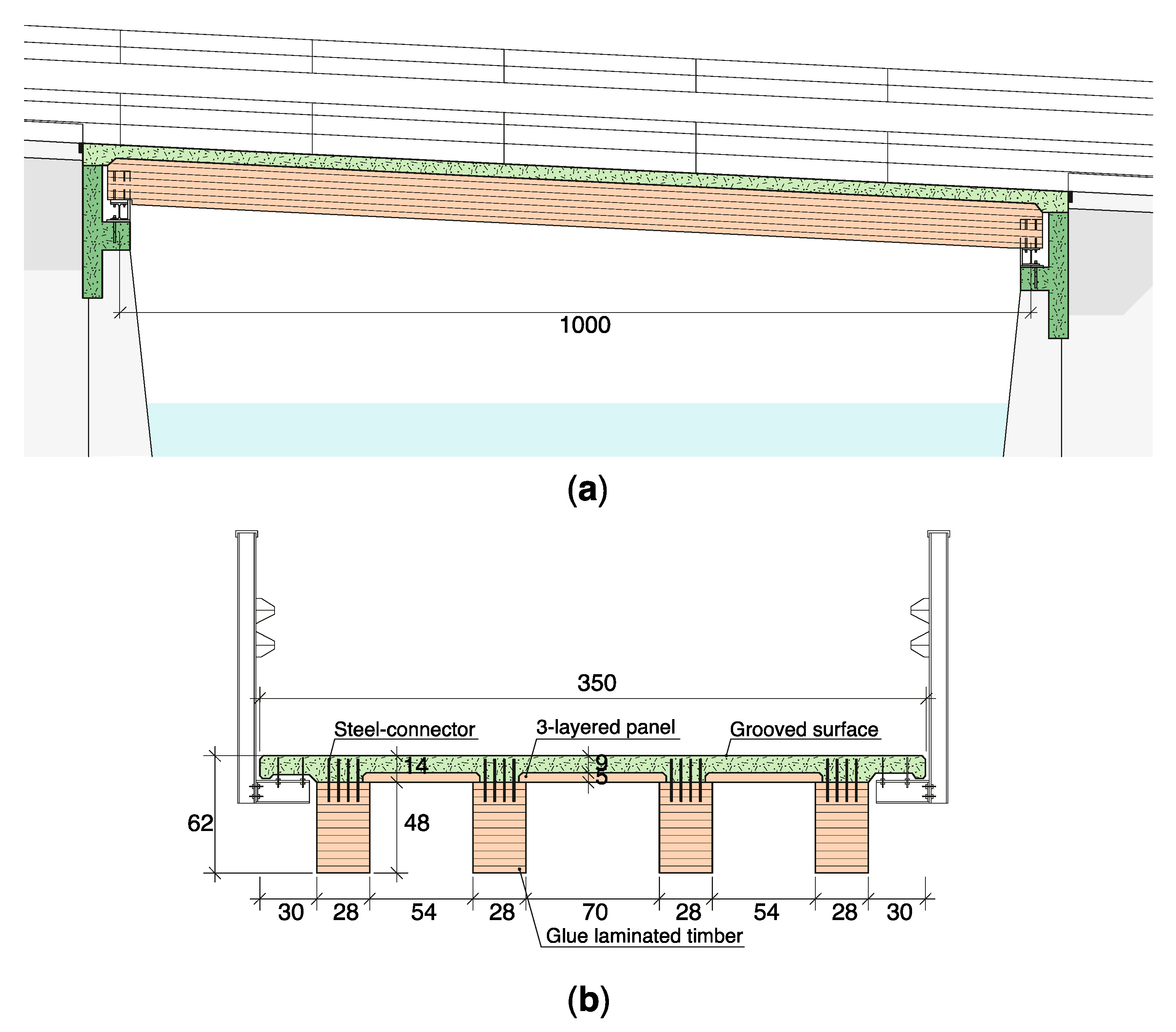
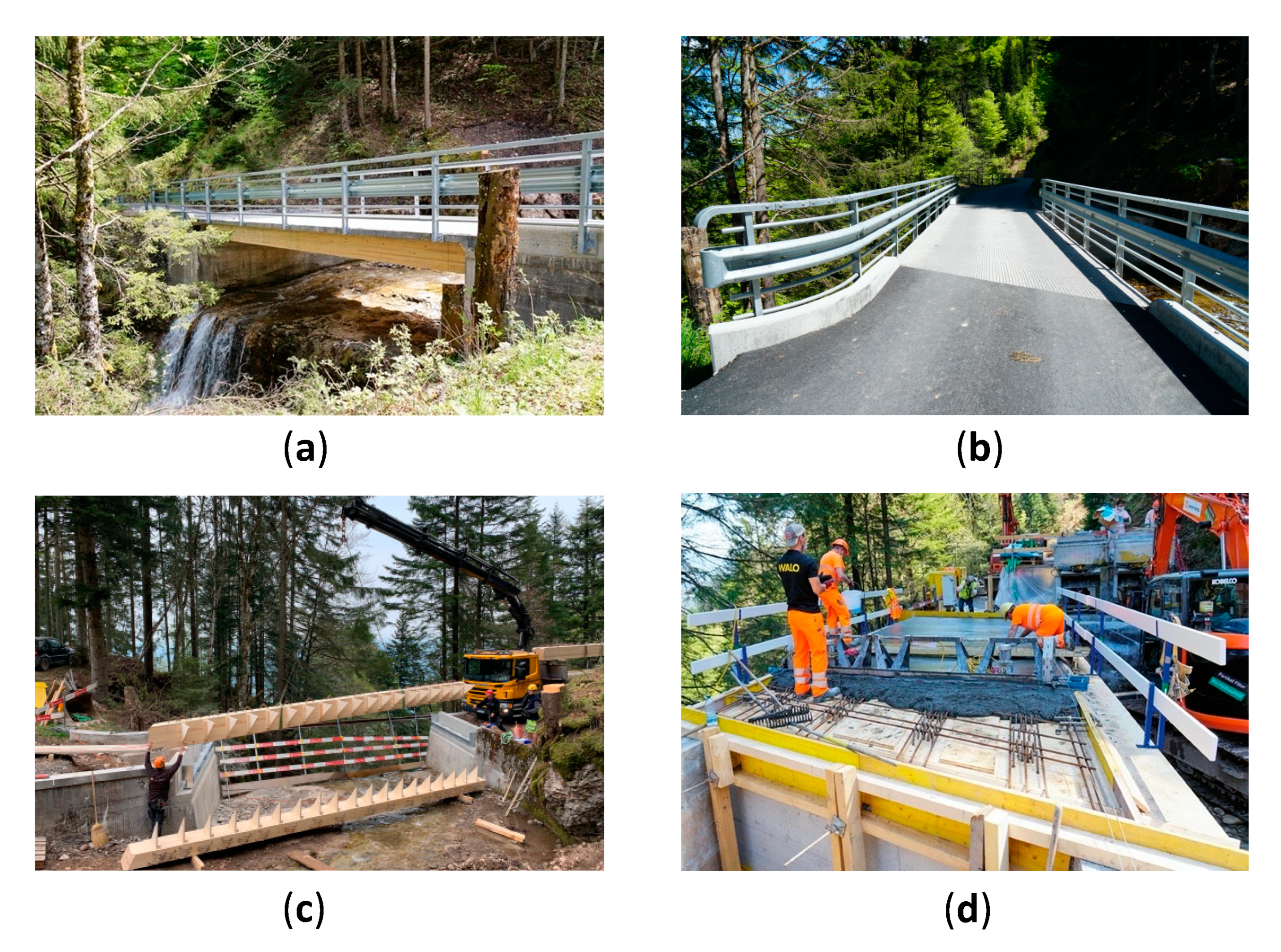
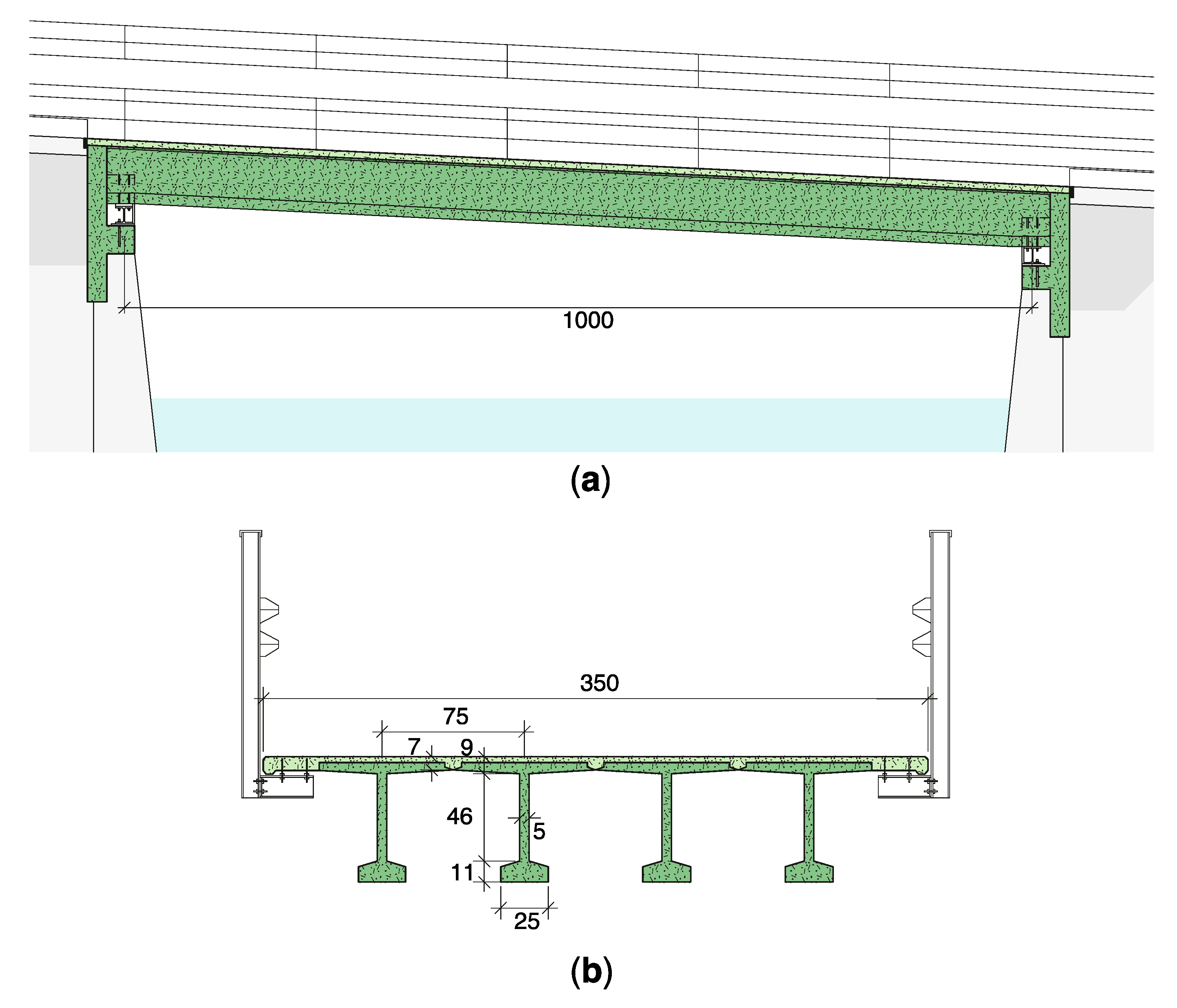
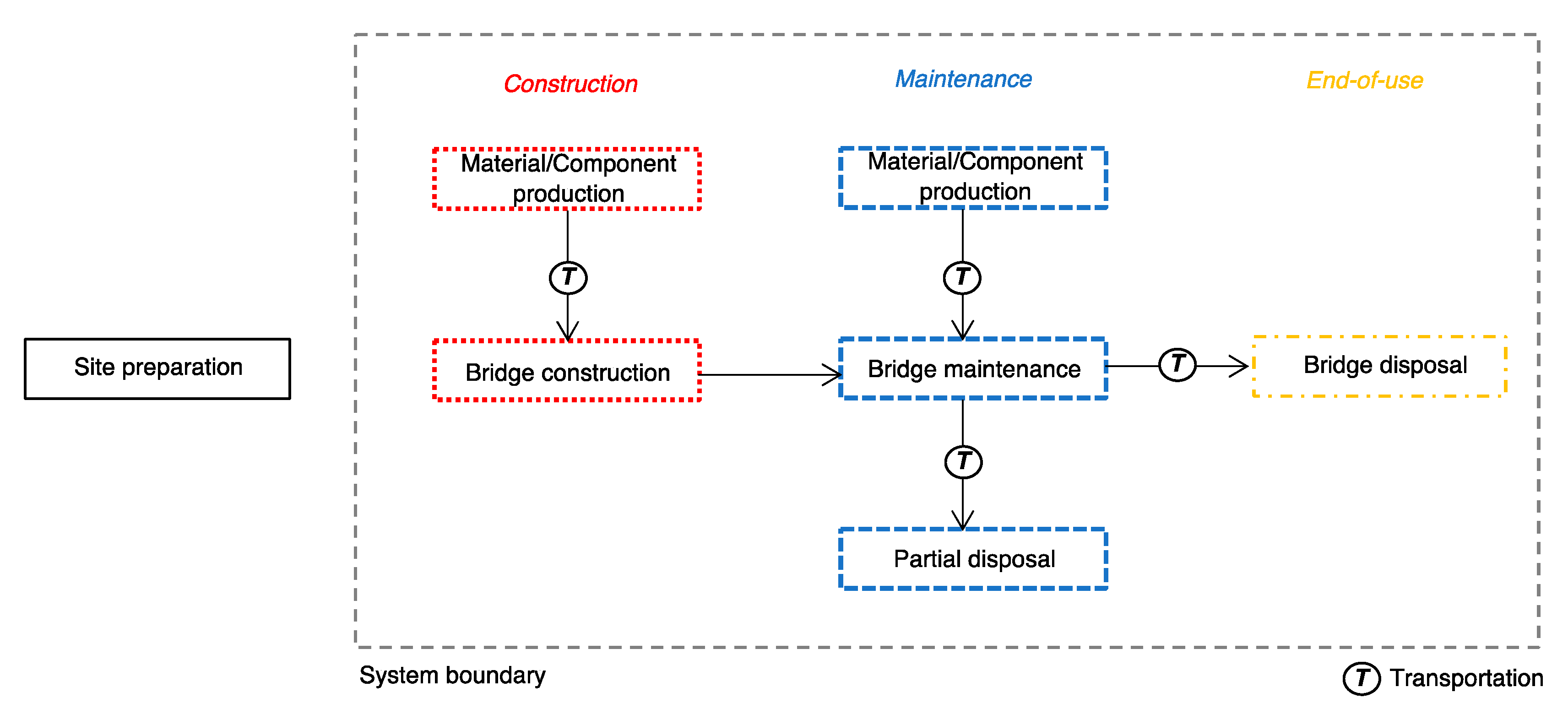
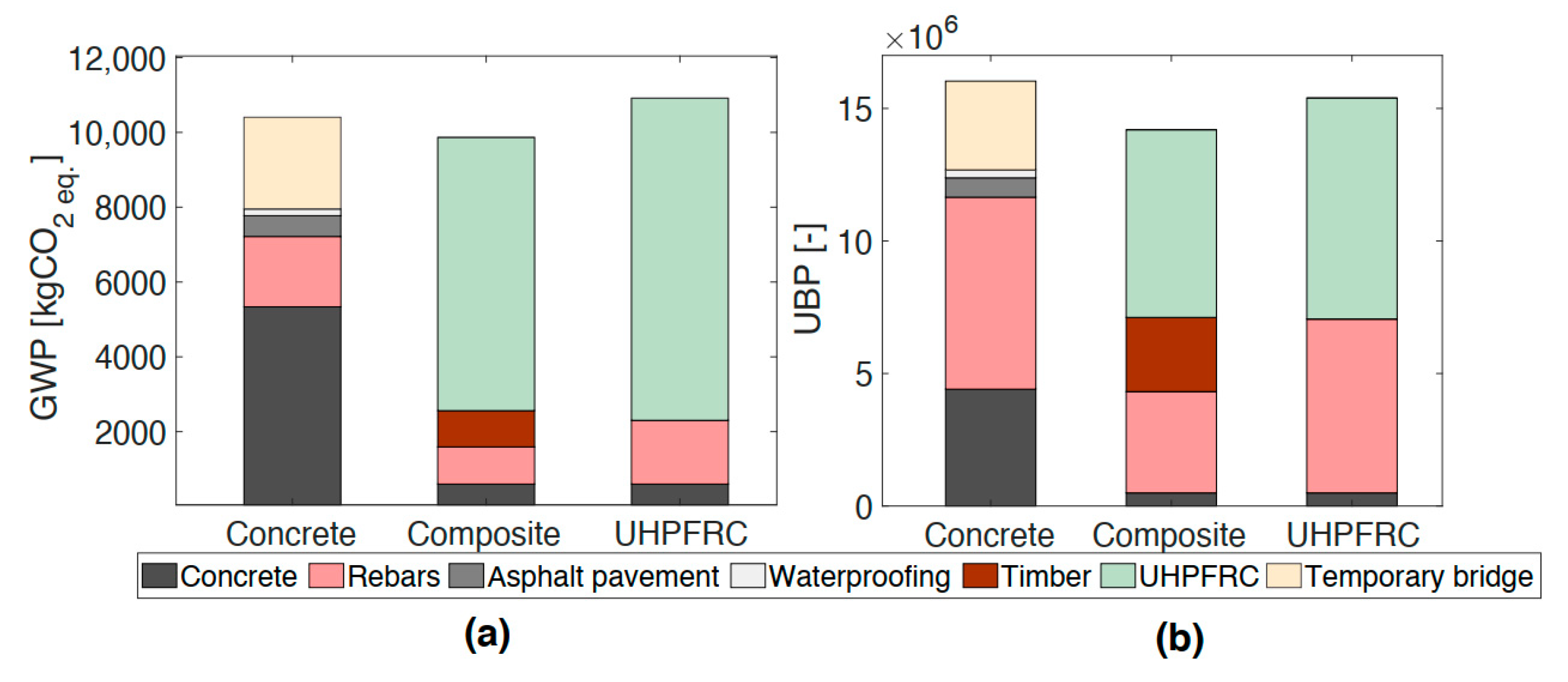


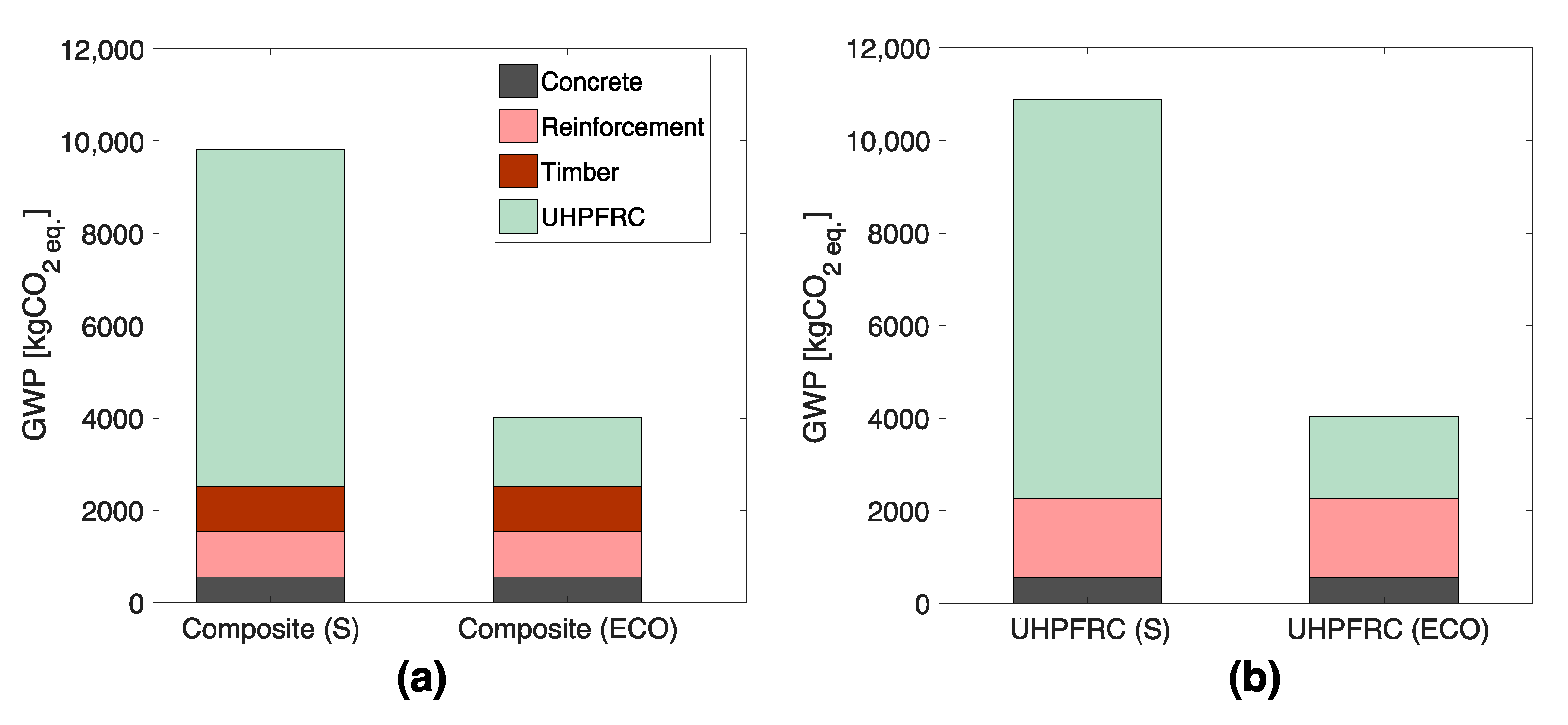
| Material Components | Distance [km] | Mix Design [kg/m3] | Total [kg] |
|---|---|---|---|
| CEM I 42.5 R | 50 | 350 | 7791 |
| Water | - | 180 | 14,469 |
| Sand | 20 | 650 | 4007 |
| Gravel | 20 | 1200 | 26,712 |
| Superplasticizer | 30 | 5 | 111 |
| Material Components | Distance [km] | Mix Design [kg/m3] | Total [kg] |
|---|---|---|---|
| Timber | 75 | - | 3000 |
| Rebars and connectors | 100 | - | 1410 |
| Concrete | 50 | 6000 | |
| UHPFRC | |||
| CEM III/N 32.5 N | 50 | 1277 | 5195 |
| Silica fume (I) | - | 96 | 391 |
| Fine quartz sand (I) | 20 | 643 | 2616 |
| Water | 173 | 704 | |
| Superplasticizer | 50 | 42 | 171 |
| Steel fibres | 21,000 | 298 | 1212 |
| Material | Quantity [kg] | Average Distance [km] |
|---|---|---|
| Concrete bridge | ||
| Concrete | 53,424 | 50 |
| Steel | 2612 | 100 |
| Asphalt Pavement | 7123 | 50 |
| Waterproofing membrane | 204 | 100 |
| Gravel (temporary bridge) | 4500 | 20 |
| Total | 63,422 | |
| UHPFRC bridge | ||
| UHPFRC beam | 12,471 | 100 |
| Steel | 2419 | 100 |
| Concrete | 6000 | 50 |
| Total | 20,987 | |
| Composite bridge | ||
| UHPFRC | 10,577 | 50 |
| Steel | 1410 | 100 |
| Timber | 3000 | 75 |
| Concrete | 6000 | 50 |
| Total | 20,890 | |
| Material | Fabrication GWP [kg CO2eq] | Transport GWP [kg CO2eq] | Total Construction GWP [kg CO2eq] |
|---|---|---|---|
| Concrete bridge | |||
| Concrete | 4755 | 582 | 5337 |
| Rebars | 1822 | 58 | 1880 |
| Temporary bridge | 247 | 2200 | 2447 |
| Asphalt | 479 | 78 | 556 |
| Waterproofing membrane | 180 | 4 | 184 |
| Total | 7235 | 3170 | 10,404 |
| UHPFRC bridge | |||
| UHPFRC | 8340 | 272 | 8612 |
| Steel | 1650 | 53 | 1703 |
| Concrete | 534 | 65 | 599 |
| Total | 10,524 | 390 | 10,914 |
| Composite bridge | |||
| UHPFRC | 7073 | 231 | 7304 |
| Steel | 960 | 31 | 992 |
| Timber | 945 | 25 | 970 |
| Concrete | 534 | 65 | 599 |
| Total | 9514 | 352 | 9866 |
| Material | Fabrication UBP × 106 [-] | Transport UBP × 106 [-] | Total Construction UBP × 106 [-] |
|---|---|---|---|
| Concrete bridge | |||
| Concrete | 3.60 | 0.82 | 4.41 |
| Rebars | 7.16 | 0.08 | 7.24 |
| Temporary bridge | 0.29 | 3.06 | 3.35 |
| Asphalt | 0.62 | 0.11 | 0.73 |
| Waterproofing membrane | 0.29 | 0.06 | 0.30 |
| Total | 11.7 | 4.36 | 16.0 |
| UHPFRC bridge | |||
| UHPFRC | 7.96 | 0.38 | 8.34 |
| Rebars | 6.48 | 0.07 | 6.56 |
| Concrete | 0.40 | 0.09 | 0.49 |
| Total | 14.9 | 0.54 | 15.4 |
| Composite bridge | |||
| UHPFRC | 6.76 | 0.32 | 7.08 |
| Rebars and connectors | 3.78 | 0.04 | 3.82 |
| Timber | 2.86 | 0.03 | 2.89 |
| Concrete | 0.40 | 0.09 | 0.049 |
| Total | 13.8 | 0.49 | 14.3 |
| Material | Element Service Duration | Maintenance GWP [kg CO2eq] | Maintenance UBP × 106 [-] | Elimination GWP [kg CO2eq] | Elimination UBP × 106 [-] |
|---|---|---|---|---|---|
| Concrete bridge | |||||
| Concrete | 40 | 589 | 0.59 | 556 | 1.33 |
| Rebars | 80+ | 0 | 0 | 0 | 0 |
| Asphalt | 20 | 1799 | 2.34 | 43.4 | 0.02 |
| Waterproofing membrane | 20 | 2008 | 1.62 | 483.6 | 0.23 |
| Total | 4391 | 4.55 | 1083 | 1.73 | |
| UHPFRC bridge | |||||
| UHPFRC | 80+ | 0 | 0 | 259 | 0.67 |
| Steel | 80+ | 0 | 0 | 0 | 0 |
| Concrete | 80+ | 0 | 0 | 62 | 0.16 |
| Total | 0 | 0 | 322 | 0.84 | |
| Composite bridge | |||||
| UHPFRC | 80+ | 0 | 0 | 220 | 0.57 |
| Steel | 80+ | 0 | 0 | 0 | 0 |
| Timber | 80+ | 0 | 0 | 363 | 0.26 |
| Concrete | 80+ | 0 | 0 | 62 | 0.16 |
| Total | 0 | 0 | 645 | ||
Publisher’s Note: MDPI stays neutral with regard to jurisdictional claims in published maps and institutional affiliations. |
© 2021 by the authors. Licensee MDPI, Basel, Switzerland. This article is an open access article distributed under the terms and conditions of the Creative Commons Attribution (CC BY) license (https://creativecommons.org/licenses/by/4.0/).
Share and Cite
Bertola, N.; Küpfer, C.; Kälin, E.; Brühwiler, E. Assessment of the Environmental Impacts of Bridge Designs Involving UHPFRC. Sustainability 2021, 13, 12399. https://doi.org/10.3390/su132212399
Bertola N, Küpfer C, Kälin E, Brühwiler E. Assessment of the Environmental Impacts of Bridge Designs Involving UHPFRC. Sustainability. 2021; 13(22):12399. https://doi.org/10.3390/su132212399
Chicago/Turabian StyleBertola, Numa, Célia Küpfer, Edgar Kälin, and Eugen Brühwiler. 2021. "Assessment of the Environmental Impacts of Bridge Designs Involving UHPFRC" Sustainability 13, no. 22: 12399. https://doi.org/10.3390/su132212399
APA StyleBertola, N., Küpfer, C., Kälin, E., & Brühwiler, E. (2021). Assessment of the Environmental Impacts of Bridge Designs Involving UHPFRC. Sustainability, 13(22), 12399. https://doi.org/10.3390/su132212399






